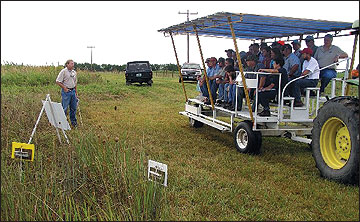Conclusion
This case study was developed to demonstrate the planning process used at the MU BREC to determine and implement a variety of wildlife management practices for achieving the identified wildlife conservation goals and objectives. The process consisted of the following tasks:
- Identify and develop an understanding of the resource problem or potential management opportunity.
- Determine wildlife goals for the property.
- Consider the seasonal habitats of the species of interest.
- Conduct a habitat appraisal to identify habitat components that are limiting, or in short supply.
- Determine the plant communities that will provide these important habitat components.
- Identify and implement management practices that create and maintain these plant communities.
- Evaluate and modify the plan to address future needs.
This case study outlines an objective-driven planning process for creating and managing high-quality early successional vegetation for bobwhite quail and a variety of wildlife — a process that agriculture producers and landowners can adopt for improving their properties for wildlife. Wildlife habitats were once thought of as an accidental by-product of agricultural practices on farms in Missouri, but that is no longer the case. Today, planning and management are required to ensure that farms contain habitats to support populations of a variety of wildlife species, particularly species that require early successional plant communities.
Landowners, natural resource professionals and wildlife enthusiasts participate in a variety of educational events conducted each year at the MU BREC. These events include field days, tours and workshops that provide information on integrating wildlife habitat into the agricultural landscape and on farms in Missouri (Figure 33). The habitat management demonstrations and this case study can serve as models to be followed by landowners interested in managing wildlife on their properties and implementing objective-driven management practices that can be integrated with the agricultural goals of their farms.
 Figure 33. Wildlife habitat management practices are demonstrated at MU BREC educational events.
Figure 33. Wildlife habitat management practices are demonstrated at MU BREC educational events.
Additional information
Missouri Department of Conservation
U.S. Department of Agriculture
- JS-15, Prescribed burning for wildlife (PDF)
- JS-18, Edge feathering — Forest edge (PDF)
- JS-19, Quail covey headquarters (PDF)
- JS-21, Downed tree structure (PDF)
- JS-24, Disking for early successional habitat (PDF)
Other NRCS publications
- CP-33 Specification Sheet, Habitat buffers for upland birds